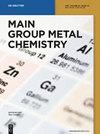New cyclic and spirocyclic aminosilanes
IF 1.2
3区 化学
Q3 CHEMISTRY, INORGANIC & NUCLEAR
引用次数: 4
Abstract
Abstract New cyclic and spirocyclic aminosilanes were synthesised using ethylenediamine, 2-aminobenzylamine, 1,8-diaminonaphthalene, o-phenylenediamine, and trans-cyclohexane-1,2-diamine as starting material. These diamines were converted into aminosilanes using silicon tetrachloride and dimethyldichlorosilane directly and via the N,N’-bis(trimethylsilylated) amino derivatives. 15 new compounds of the type (diamino)(SiMe3)2, (diamino)2Si, (diamino)SiMe2, and (diamino)SiCl2 have been prepared. The formation of two cyclotrisilazane derivatives was observed starting from (N,N’-2-aminobenzylamino)dichlorosilane by trimerisation. All synthesised compounds have been characterised with NMR-, Raman-, or IR-spectroscopy, mass-spectrometry, and boiling or melting point. Single-crystal X-ray structure analyses of several derivatives have been performed. The degree of substitution with trimethylsilyl groups in the final compounds depends on the ring size of the spirocycles. It was shown with quantum chemical calculations on the M062X/6-31G(d) level that trimethylsilyl groups have a stabilising effect on 5-membered ring systems and a destabilising effect on 6-membered rings in these compounds.新型环状和螺环氨基硅烷
摘要以乙二胺、2-氨基苄胺、1,8-二氨基萘、邻苯二胺和反式环己烷-1,2-二胺为原料合成了新型环和螺环氨基硅烷。这些二胺通过四氯化硅和二甲基二氯硅烷直接或通过N,N ' -二(三甲基硅基化)氨基衍生物转化为氨基硅烷。合成了15种新型(二氨基)(SiMe3)2、(二氨基)2Si、(二氨基)SiMe2和(二氨基)SiCl2化合物。以(N,N′-2-氨基苄胺)二氯硅烷为起始原料,经三聚反应生成了两个环三氮杂烷衍生物。所有合成的化合物都用核磁共振、拉曼或红外光谱、质谱和沸点或熔点进行了表征。对几种衍生物进行了单晶x射线结构分析。最终化合物中与三甲基硅基取代的程度取决于螺环的环大小。在M062X/6-31G(d)水平上的量子化学计算表明,三甲基硅基对这些化合物的5元环体系具有稳定作用,对6元环具有不稳定作用。
本文章由计算机程序翻译,如有差异,请以英文原文为准。
求助全文
约1分钟内获得全文
求助全文
来源期刊

Main Group Metal Chemistry
CHEMISTRY, INORGANIC & NUCLEAR-CHEMISTRY, ORGANIC
CiteScore
4.10
自引率
27.80%
发文量
21
审稿时长
4 weeks
期刊介绍:
This journal is committed to the publication of short communications, original research, and review articles within the field of main group metal and semi-metal chemistry, Main Group Metal Chemistry is an open-access, peer-reviewed journal that publishes in ongoing way. Papers addressing the theoretical, spectroscopic, mechanistic and synthetic aspects of inorganic, coordination and organometallic main group metal and semi-metal compounds, including zinc, cadmium and mercury are welcome. The journal also publishes studies relating to environmental aspects of these metals, their toxicology, release pathways and fate. Articles on the applications of main group metal chemistry, including in the fields of polymer chemistry, agriculture, electronics and catalysis, are also accepted.
 求助内容:
求助内容: 应助结果提醒方式:
应助结果提醒方式:


